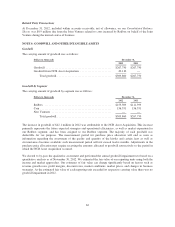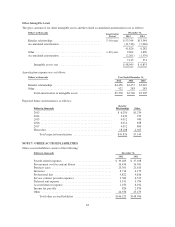Redbox 2012 Annual Report Download - page 60
Download and view the complete annual report
Please find page 60 of the 2012 Redbox annual report below. You can navigate through the pages in the report by either clicking on the pages listed below, or by using the keyword search tool below to find specific information within the annual report.Internal-Use Software
We capitalize costs incurred to develop or obtain internal-use software during the application development stage.
Capitalization of software development costs occurs after the preliminary project stage is complete, management
authorizes the project, and it is probable that the project will be completed and the software will be used for the
function intended. We expense costs incurred for training, data conversion, and maintenance, as well as spending
in the post-implementation stage. A subsequent addition, modification or upgrade to internal-use software is
capitalized only to the extent that it enables the software to perform a task it previously could not perform. The
internal-use software is included in computers and software under property and equipment in our Consolidated
Balance Sheets. We amortize the internal-use software based on the estimated useful life on a straight-line basis.
Intangible Assets Subject to Amortization
Our intangible assets subject to amortization are comprised primarily of retailer relationships acquired in
connection with our acquisitions. We used expectations of future cash flows to estimate the fair value of the
acquired retailer relationships. We amortize our intangible assets on a straight-line basis over their expected
useful lives.
Goodwill
Goodwill represents the excess purchase price of an acquired enterprise or assets over the estimated fair value of
identifiable net assets acquired. We assess goodwill for potential impairment at the reporting unit level on an
annual basis as of November 30, or whenever an event occurs or circumstances change that would more likely
than not reduce the fair value of a reporting unit below its carrying amount. We may assess qualitative factors to
make this determination, or bypass such a qualitative assessment and proceed directly to testing goodwill for
impairment using a two-step process. Qualitative factors we may consider include, but are not limited to,
macroeconomic conditions, industry conditions, the competitive environment, changes in the market for our
products and services, regulatory and political developments, entity specific factors such as strategies and
financial performance. If, after completing such assessment, it is determined more likely than not that the fair
value of a reporting unit is less than its carrying value, we proceed to a two-step impairment test, whereby the
first step is comparing the fair value of a reporting unit with its carrying amount, including goodwill. If the fair
value of a reporting unit exceeds its carrying amount, goodwill of the reporting unit is considered not impaired
and the second step of the test is not performed. The second step of the impairment test is performed when the
carrying amount of the reporting unit exceeds the fair value, then the implied fair value of the reporting unit
goodwill is compared with the carrying amount of that goodwill. If the carrying amount of the reporting unit
goodwill exceeds the implied fair value of that goodwill, an impairment loss shall be recognized in an amount
equal to the excess. For additional information see Note 6: Goodwill and Other Intangible Assets.
Lives and Recoverability of Equipment and Other Long-Lived Assets
We evaluate the estimated remaining life and recoverability of equipment and other assets, including intangible
assets subject to amortization, whenever events or changes in circumstances indicate that the carrying amount of
the asset may not be recoverable. Factors that would indicate potential impairment include, but are not limited to,
significant decreases in the market value of the long-lived asset(s), a significant change in the long-lived asset’s
use or physical condition, and operating or cash flow losses associated with the use of the long-lived asset. When
there is an indication of impairment, we prepare an estimate of future, undiscounted cash flows expected to result
from the use of the asset and its eventual disposition to test recoverability. If the sum of the future undiscounted
cash flow is less than the carrying value of the asset, it indicates that the long-lived asset is not recoverable, in
which case we will then compare the estimated fair value to its carrying value. If the estimated fair value is less
than the carrying value of the asset, we recognize the impairment loss and adjust the carrying amount of the asset
to its estimated fair value.
53
























